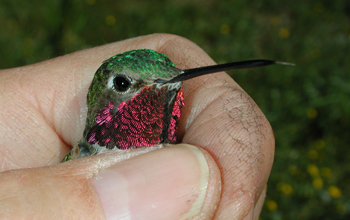Multimedia Gallery
Male broad-tailed hummingbird in researcher's hand
A male broad-tailed hummingbird (Selasphorus platycercus) rests briefly in a researcher's hand at the Rocky Mountain Biological Laboratory. The dusting of yellow pollen at the base of its bill may have come from a glacier lily flower (Erythronoium grandiflorum), the first of the wildflowers to bloom in the spring when migratory birds arrive from their winter homes in Mexico.
More About This Image
The glacier lily flowers are flowering earlier as the climate warms, with a record early flowering in 2012. Flowering now begins before the hummingbirds arrive.
In a research study funded by the National Science Foundation's Division of Environmental Biology (grant DEB 0922080), David Inouye and Amy McKinney of the University of Maryland and colleagues found that the lilies are blooming some 17 days earlier than they did in the 1970s. This means that their blooming is no longer in synch with the arrival of the hummingbirds that rely on the nectar. By the time the hummingbirds arrive, many of the flowers have withered away along with their nectar-filled blooms.
Each spring, the broad-tailed hummingbirds fly north from Central America to the Western U.S. Here in these high-mountain breeding grounds they will raise their young over the short mountain summer. Males actually arrive before the flowers bloom to scout for territory.
But, says Inouye and McKinney, the time between the arrival of the first hummingbird and the first bloom has collapsed by 13 days over the past four decades. "In some years," says McKinney, "the lilies have already bloomed by the time the first hummingbird lands."
Broad-tailed hummingbirds that breed farther south in states like Arizona, however, are less affected. Inouye says there is no obvious narrowing of the timing between the first arriving males and the first blooms of their favored flowering plant, the nectar-containing Indian paintbrush.
Global warming is happening faster in the higher latitudes, making these areas more likely to get out of sync ecologically. At the rate things are going, if the snowmelt continues to occur earlier in the spring, bringing earlier flowering, then the mountains will bloom with lilies long before the hummingbirds can finish their migratory journey north. (Date of Image: Unknown)
Credit: Photo by David W. Inouye
See other images like this on your iPhone or iPad download NSF Science Zone on the Apple App Store.
Images and other media in the National Science Foundation Multimedia Gallery are available for use in print and electronic material by NSF employees, members of the media, university staff, teachers and the general public. All media in the gallery are intended for personal, educational and nonprofit/non-commercial use only.
Images credited to the National Science Foundation, a federal agency, are in the public domain. The images were created by employees of the United States Government as part of their official duties or prepared by contractors as "works for hire" for NSF. You may freely use NSF-credited images and, at your discretion, credit NSF with a "Courtesy: National Science Foundation" notation.
Additional information about general usage can be found in Conditions.
Also Available:
Download the high-resolution JPG version of the image. (1.8 MB)
Use your mouse to right-click (Mac users may need to Ctrl-click) the link above and choose the option that will save the file or target to your computer.



 All images in this series
All images in this series